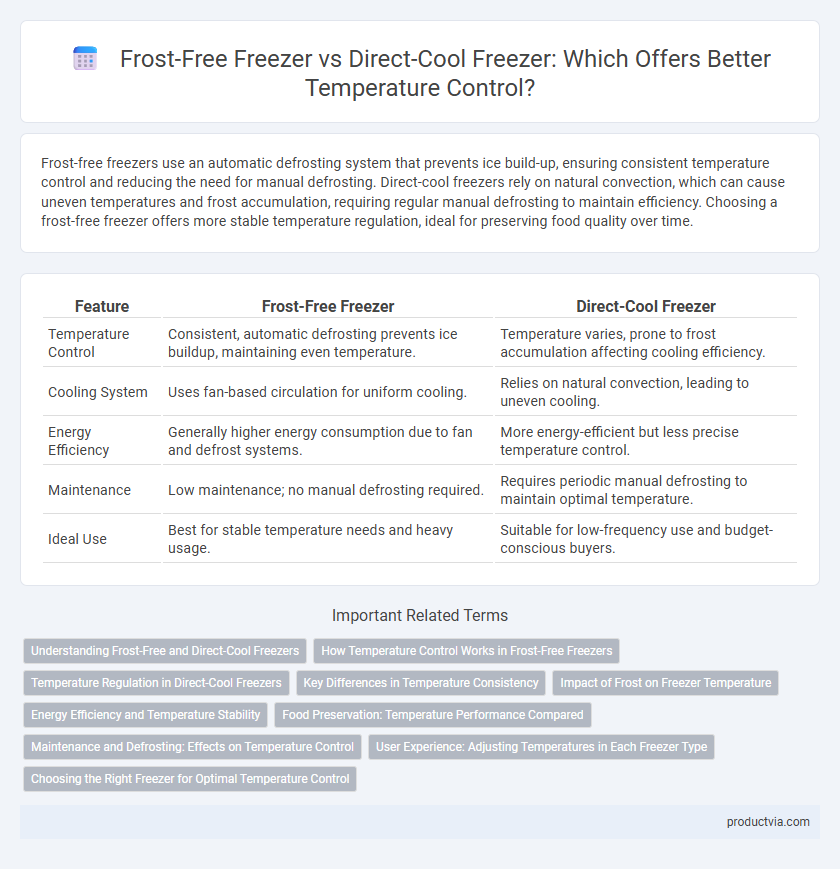Frost-free freezers use an automatic defrosting system that prevents ice build-up, ensuring consistent temperature control and reducing the need for manual defrosting. Direct-cool freezers rely on natural convection, which can cause uneven temperatures and frost accumulation, requiring regular manual defrosting to maintain efficiency. Choosing a frost-free freezer offers more stable temperature regulation, ideal for preserving food quality over time.
Table of Comparison
| Feature | Frost-Free Freezer | Direct-Cool Freezer |
|---|---|---|
| Temperature Control | Consistent, automatic defrosting prevents ice buildup, maintaining even temperature. | Temperature varies, prone to frost accumulation affecting cooling efficiency. |
| Cooling System | Uses fan-based circulation for uniform cooling. | Relies on natural convection, leading to uneven cooling. |
| Energy Efficiency | Generally higher energy consumption due to fan and defrost systems. | More energy-efficient but less precise temperature control. |
| Maintenance | Low maintenance; no manual defrosting required. | Requires periodic manual defrosting to maintain optimal temperature. |
| Ideal Use | Best for stable temperature needs and heavy usage. | Suitable for low-frequency use and budget-conscious buyers. |
Understanding Frost-Free and Direct-Cool Freezers
Frost-free freezers use an auto-defrost mechanism combined with a fan to circulate air, maintaining consistent temperatures and preventing ice buildup. Direct-cool freezers rely on natural convection to cool, leading to occasional frost accumulation that requires manual defrosting. Understanding these systems helps consumers choose the right freezer based on maintenance preferences and temperature consistency needs.
How Temperature Control Works in Frost-Free Freezers
Frost-free freezers maintain temperature control through an automatic defrosting system that circulates warm air periodically to prevent ice build-up on the evaporator coils. The built-in thermostat measures the internal temperature and activates the heating element to melt any frost, ensuring consistent cooling without manual defrosting. This system enables uniform temperature distribution and prevents ice obstruction, improving overall efficiency and food preservation.
Temperature Regulation in Direct-Cool Freezers
Direct-cool freezers rely on natural convection to circulate cold air, causing temperature fluctuations that can lead to uneven cooling and occasional frost buildup. Their temperature regulation tends to be less precise compared to frost-free freezers, which use fans and automatic defrost cycles to maintain consistent cold conditions. This variability in direct-cool freezers can affect food preservation, requiring more frequent manual defrosting and temperature monitoring.
Key Differences in Temperature Consistency
Frost-free freezers maintain more consistent temperatures by using an automatic defrost cycle that prevents ice build-up on the walls, ensuring even cooling throughout the compartment. Direct-cool freezers rely on natural convection for cooling, often resulting in temperature fluctuations and localized cold spots due to frost accumulation. The consistent temperature control in frost-free freezers helps preserve food quality longer and reduces manual defrosting needs.
Impact of Frost on Freezer Temperature
Frost-free freezers maintain consistent temperature by automatically preventing ice buildup, which ensures optimal food preservation and energy efficiency. Direct-cool freezers tend to develop frost over time, causing uneven temperature distribution and requiring manual defrosting to maintain performance. The accumulation of frost in direct-cool models disrupts cold air circulation, leading to temperature fluctuations that can compromise food quality.
Energy Efficiency and Temperature Stability
Frost-free freezers use a fan-forced air circulation system to maintain consistent temperatures and prevent ice buildup, resulting in more stable temperature control but higher energy consumption. Direct-cool freezers rely on natural convection for cooling, offering superior energy efficiency but leading to uneven temperature distribution and occasional frost accumulation. Choosing between the two depends on prioritizing energy savings or temperature stability for food preservation.
Food Preservation: Temperature Performance Compared
Frost-free freezers maintain consistent temperatures by using automatic defrost cycles, preventing ice build-up that can affect food quality and ensuring uniform cooling for optimal food preservation. Direct-cool freezers rely on natural convection for cooling, which often leads to uneven temperature distribution and frost accumulation, potentially compromising the shelf life and texture of stored food. Temperatures in frost-free models typically fluctuate less, providing better performance in preserving food freshness compared to direct-cool freezers.
Maintenance and Defrosting: Effects on Temperature Control
Frost-free freezers feature an automatic defrosting system that prevents ice buildup, ensuring consistent temperature control without manual intervention. Direct-cool freezers require periodic manual defrosting, which can cause temperature fluctuations during the defrost cycle, potentially affecting food preservation. Maintenance is simpler with frost-free freezers due to reduced ice formation, promoting more stable internal temperatures and efficient cooling performance.
User Experience: Adjusting Temperatures in Each Freezer Type
Frost-free freezers maintain consistent temperature through automatic defrost cycles, allowing users to easily set and maintain precise temperature levels without manual intervention. Direct-cool freezers require occasional manual defrosting, which can cause temperature fluctuations, making temperature adjustments less immediate and potentially impacting food preservation. Users typically find frost-free freezers more convenient for maintaining steady cold conditions, while direct-cool models demand more attention to temperature control.
Choosing the Right Freezer for Optimal Temperature Control
Frost-free freezers maintain a consistent temperature by circulating air to prevent ice buildup, ensuring efficient temperature control without manual defrosting. Direct-cool freezers rely on natural convection, which can lead to uneven temperatures and occasional frost accumulation, requiring regular manual defrosting to maintain optimal performance. Choosing the right freezer depends on prioritizing consistent temperature regulation and ease of maintenance, with frost-free models typically offering superior temperature stability for sensitive food storage.
Frost-free freezer vs direct-cool freezer for temperature control Infographic

 productvia.com
productvia.com